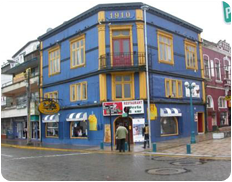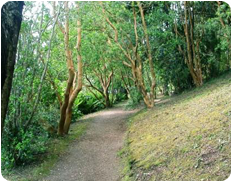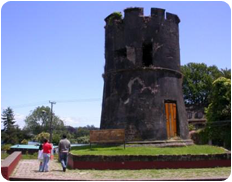Why smart travellers choose LYS! Find out more
Travelogues
- Home
- Travelogues
- Valdivia
Valdivia
- John Koelsch

Surrounded by densely wooded hills and situated at the confluence of multiple navigable rivers only a short distance inland from the Pacific, Valdivia ranks as one of Chile’s most attractive and important cities. The region is blessed with a lush and flowering natural beauty that has been augmented by the distinctive old-world charm that reflects the historic influence from the city’s 19th Century German immigrant heritage. In addition to that, the city has long been established as the major transportation and commercial hub for the Lakes District and also the fact that it is a unique town that vibrates with the youthful energies of the many students living there who attend the splendid Universidad Austral de Chile, located on Isla Teja, just across the bridge spanning the Río Valdivia from the colorful city center.
The historic city of Valdivia was originally founded as a strategic Spanish outpost in the middle of the Mapuche Indian territories by Pedro de Valdivia in 1552. It was destroyed during the major Mapuche insurrection of 1599, after which it was briefly occupied by Dutch pirates, who finally abandoned an effort to establish a more permanent Dutch enclave there in the 1640's. In 1645 the Viceroy of Peru ordered that the city be re-established again as a Spanish garrison, and a large expedition was sent there to build the city of Valdivia into a walled fortress that would be further protected by the construction of multiple forts down river at the mouth of the Río Valdivia. It became one of the greatest fortifications in Spanish America, a bulwark that guarded the interests of the Spanish Crown in the area for the next 175 years, remaining one of the last bastions holding out for the royalist cause during the battles for independence. It finally fell in 1820 to a force led by Lord Thomas Cochrane, the founder of the Chilean navy.

Beginning in the 1850's, the city was transformed by the influx of successive waves of German and Swiss immigrants. Some of these Europeans were drawn to Valdivia and the rich soils of the interior valleys which promised a vast agricultural potential, while others came to the city to set up shop as merchants and as founders of industry. These settlers brought with them a strict sense of professionalism and a solid work ethic, and their efforts turned Valdivia into the leading industrial center in this part of Chile.
The resulting prosperity that grew out of hard work and ingenuity continued to shape the city as the 20th century progressed, but all that was suddenly disrupted in a most dramatic fashion on May 22, 1960, when the region was rocked by a massive earthquake, registering an incredible 8.9 on the Richter scale. The blow destroyed the majority of the buildings that had been built in the classic traditional German-style architecture, but more significantly, the city’s waterfront disappeared under the river’s waters while vast stretches of farmland in the vicinity became inundated as well, transformed almost instantly into wetlands, thanks to the fact that the land itself had sunk a full three meters. Since that time, the city has been completely rebuilt, and although the rebuilding may seem to have diluted the historic German influence to some degree, the visitor can easily see that the old-world feel still marks the city’s character.
Things to see and do

Even though the size of Valdivia (population approximately 120,000 people) might suggest that a need to either have a vehicle or to check out the bus system, the actual city center is quite compact, so it is easy to take in much the best the city can offer on foot, even for destinations across the river on Isla Teja. Starting at the comfortable and shady Plaza de la República in the heart of downtown one can stroll just three short blocks east to the river front with its famed Feria Fluvial, a colorful open air market where vendors are selling quantities of fresh seafood, fruits and vegetables, which has often just arrived by boat from either the coast or the interior. Just south of this attraction there on the waterfront is the Muelle Schuster, where a host of various boats offering river tours to the city’s visitors are moored. Across the street from the waterfront are a number of excellent sea food restaurants, and the sharp-eyed hostesses are competitive in their efforts to woo potential patrons amongst the many passers by at lunchtime.

For those interested to see the best of the traditional German-built homes that survived the 1960 earthquake, a stroll south along Calle General Lagos, which is the extension of Calle Yungay after it leaves the built up part of the city center. Most of the homes were built back in the mid- to late- 19th Century. On this same walk, visitors will encounter the Torreón Los Canelos, a stone buttress that was built in 1781 and is a remnant of the city’s old defensive wall.
There are also a couple of museums worth checking out, including the Museo Historico y Arqueológico Mauricio ven de Maele, which contains exhibits of Mapuche Indian artifacts as well as items from colonial times and an exhibit on the German immigration. This museum is directly across the river from Muelle Schuster in Isla Teja. Another museum is the Museo de Arte Contemporáneo with rotating exhibitions of sculpture and painting that is located next to the historical museum.
Another attraction across the Río Valdivia on Isla Teja is the shady campus of the Universidad Austral, where the famous Jardín Botanico (Botanical Garden) can be found at the north end between the main campus and the Río Cau Cau. Taking time to walk along the various paths to see the many different labeled tree species from various parts of the world can be a relaxing and enjoyable way to spend an afternoon. Be aware that the garden is open during daylight hours only.
My visits to Valdivia in December 2005

I visited Valdivia twice in my 2005-2006 journey through South America, arriving for the first time on December 6th 2005, and I booked myself into the excellent Hostal Casa Grande on the east end of Valdivia centro. And although this technically is not the region’s rainy season (which is in the winter months), it rained for the first two days I was there. Of course, this did not deter me from walking through the active and vibrant downtown, it did keep me from crossing the river to visit the Jardín Botanico until December 8. Regardless of the weather I enjoyed my first three days here, perusing the downtown, enjoying the sea food cuisine, and stumbling upon a very decent little bookstore where I purchased some good reading materials to bring with me as my travels continued, with my departure on December 9 for a crossing into Argentina and an overland push south into Patagonia.
I soon returned to Valdivia following an abbreviated visit to the far south, where I had come down with a rather nasty flu bug that kept me laid up in my hotel room bed for the better part of my entire stay down in Puerto Natales. I had been planning to do all sorts of hiking and camping down below Punta Arenas and over on Tierra Del Fuego, but had realized that to do so in my condition could be encouraging worse things, like pneumonia. So I resolved to make it back to the pleasant city of Valdivia, to settle down once again at the Hostal Casa Grande to recuperate over the Christmas holiday before heading northward.

On December 24 the weather was absolutely perfect, and my flu symptoms had subsided enough that I ventured out and again toured the city, taking time to sit down and relax with one of my books on a shaded park bench overlooking the Río Valdivia on the Muelle Schuster. I did the stroll to see the German houses, visited some of the shops in the big “Mercado” which is also down by the waterfront, and took in the activities that were happening up in the plaza on this day before Christmas, with Santa Claus’s two helpers busily painting the faces of the many children who had come with their families to the city to do some last-minute Christmas shopping and to take in the community of the moment. It was all very enjoyable.
I found Valdivia to be a wonderful city to spend some quality leisure time during the course of my travels. The city’s atmosphere lends itself to a generally relaxed tempo, although I understand that there is something of an active night life there as well, especially with the many students there. But considering that I was just getting over the flu, and with the Christmas holiday in full swing, I did not seek it out, and enjoyed my stay there just the same.
Practical matters
Tourist offices - Sernatur is at Prat 555, down on the waterfront. There are plenty of banks with ATMs in the downtown area. Various internet cafes can be found around the city as well, although my hostal had their own internet connections which were available to guests. Besides the restaurants facing the waterfront there are plenty of others within walking distance of the plaza. There are also a decent number of other accommodations, especially just north and east of the downtown. Kuntsmann Brewery is located southwest of town on the road to Niebla, offering pub fare and brewery tours.
It would be great if you send us you own travelogue. If you decide to do it, please email it to rent@lys.cl along with photos of your chilean experience. Your comments will help other people to plan their trip. Please try to write only one travelogue per location, otherwise it will be hard for us to indicate what is the travelogue about (we need to put a title to your travelogue).

Contact us by telephone
- Our WhatsApp number, only for emergencies of our active clients, is:
WhatsApp: +56 977 062 967 - If you would like a quote, please fill in our
Quotation form - If you have any doubts or specific inquiries, please write us to rent@lys.cl

Why Choose LYS for Your South American Adventure?
- Local Expertise: Chilean staff work in LYS team, and we know South America like the palm of our hand
- 24/7 English Support: Travel safely with our exclusive and important English 24/7 emergency number (this is in addition to the typical given road assistance phone number, and it is very important when travelling in isolated areas, like Patagonia and Atacama Desert). If you have any issue in the middle of nowhere, for sure, you do not want to get an AI automated response or a call center in India, or any other country, which has no idea where you are located
- Authentic Content: We do not use A.I., therefore, all the information you see on our website is original and written by LYS' staff. Also, all the images in our photo galleries are real. We work like a boutique local company offering convenient rates with an unbeatable service
- Modern Fleet: We only rent modern vehicles, which is very important to avoid mechanical issues while driving in isolated areas
- Proven Track Record: LYS has been renting cars since 1994! And we have unbeatable online reviews, which you can check out here.
- We offer one-way rentals: in dropping off rental units in Chile and Argentina as well.
Here are our main one-way rentals:
| DOMESTIC ONE-WAY RENTALS | |
|---|---|
| STARTING | ENDING |
| Santiago | Arica (or viceversa) |
| Santiago | Calama / Antofagasta (or viceversa) |
| Santiago | Temuco (or viceversa) |
| Santiago | Puerto Montt (or viceversa) |
| Santiago | Puerto Natales / Punta Arenas (or viceversa) |
| Puerto Montt | Coyhaique - Balmaceda (or viceversa) |
| Puerto Montt | Puerto Natales - Punta Arenas (or viceversa) |
| INTERNATIONAL ONE-WAY RENTALS | |
|---|---|
| STARTING | ENDING |
| Santiago | Mendoza |
| Santiago | Buenos Aires |
| Santiago | Bariloche |
| Santiago | El Calafate |
| Santiago | Ushuaia |
| Punta Arenas | El Calafate |